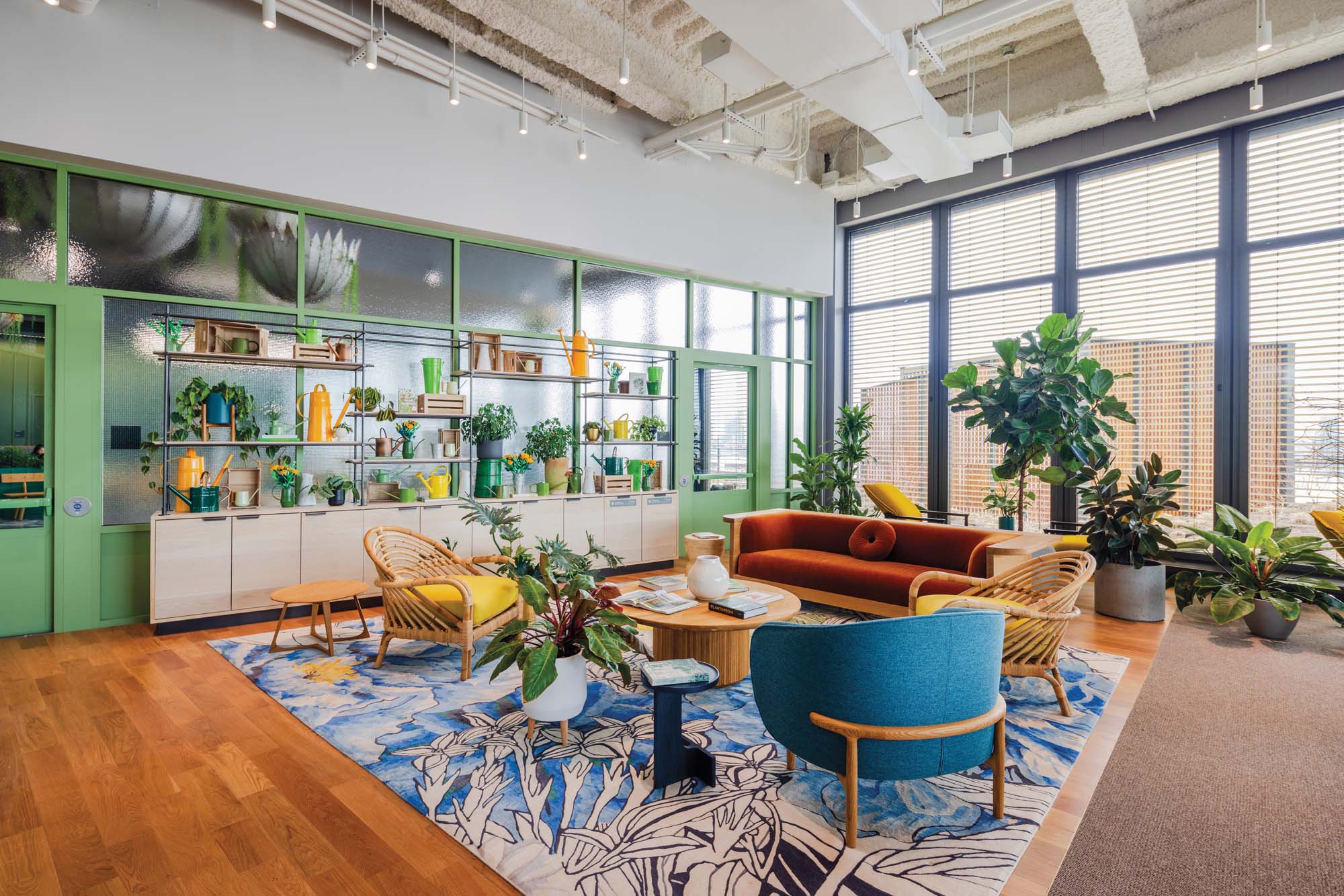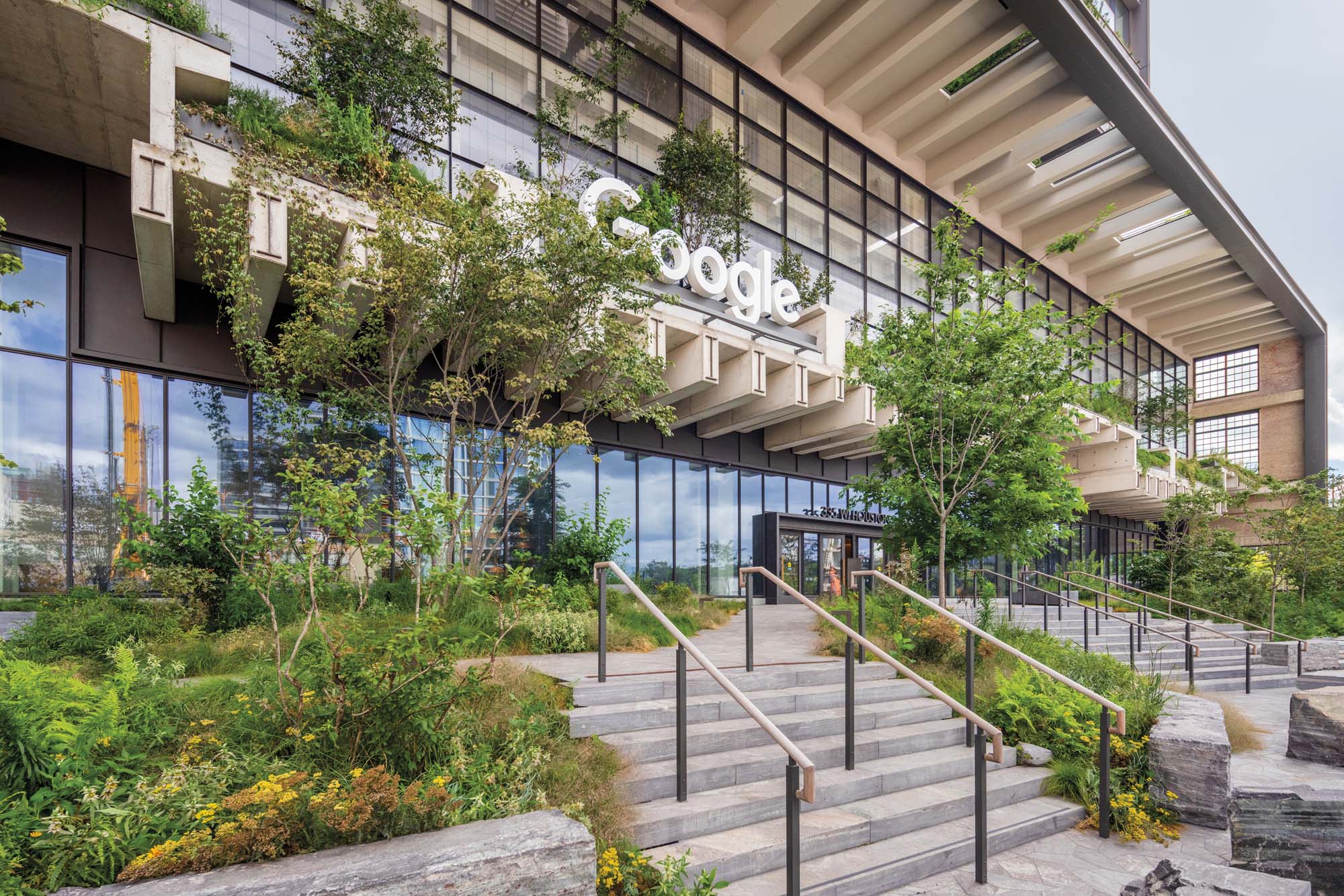St. John’s Terminal is now home to Google, which bought the building in 2021. Thanks to a collaboration between CookFox on the architecture and Gensler on the interiors, St. John’s Terminal has transformed from an austere industrial workhorse into a gleaming 1.3-million-square-foot, high-performance, LEED Platinum workplace.
Letting Sustainability Lead at Google New York
Sustainability has been the guiding ethic of the building’s revamp since before Google entered the picture. Rick Cook, the cofounder of CookFox, started studying the building in 2007 and was intrigued by the opportunities it posed from the perspective of “experimental preservation,” borrowing the term from Columbia professor Jorge Otero-Pailos. “I think it’s an evolving art form, this idea of adaptive reuse,” Cook says. “We’re riffing off the existing building fabric and creating ideas about a new type of architecture and how we evolve as a city.”
The masterstrokes involve knowing what to cut and what to keep. Cook was fascinated with how the terminal’s heft, engineered to carry the load of 227 freight-train cars, could support a taller structure. The building has a north-south orientation—rare for a groundscraper—which would be a compelling amenity to future tenants. “What we said at the time was it will have the widest sunset in Manhattan,” Cook says. During land-use community engagement sessions, residents in the area said they wanted better connections to Hudson River Park, which was blocked off by a portion of the building that straddled West Houston Street. That could go. Slicing off the northern edge of the building revealed the old rail beds, and CookFox designed around this Gordon Matta-Clark-esque feature. Recycling the bulk of the building prevented an estimated 78,400 metric tons of carbon dioxide from entering the atmosphere.

Central to the project, from the way that Google’s teams will work to how the building sits within the city, is the idea that “architecture is an art of connection,” Cook says, “The building now connects Hudson Street with the Hudson River, people with nature, people with people, and ultimately the past with the future.”
Inside, a similar spirit of environmental sensitivity—specifically the goals of reducing carbon, cultivating healthy spaces, advancing circular systems, and positively affecting people, says Mallory Taub, Gensler’s sustainability director—guided the design. Google’s in-house team, CookFox, and Gensler met weekly in person for over a year during the design phase (before the pandemic) to ensure that all decisions supported these goals.
Designed with a Focus on Wellness and Flexibility
Google’s workspaces have evolved considerably since its quirky designs of the aughts. Now, instead of novelties like Ping-Pong tables and slides between floors, the focus is on healthy spaces that will make it easier for people to do their jobs more effectively. The design team used biophilic principles—design that takes its cues from the natural world—to create spaces that will “reduce stress, refresh the brain, improve mood, and enhance creativity,” Katie Scallon, real estate project executive at Google, says.
“The interior includes live plants and wooden materials that enhance connections to nature, water references that represent the site’s original Hudson River shoreline, and nature-inspired ceiling installations that evoke tree canopies and foliage.”

Another crucial design element that helps employees work more effectively is choice. In St. John’s Terminal, as in its Mountain View headquarters, Google has a flexible “neighborhood” seating model that can accommodate all the unique ways that a team works and places where they want to work. This also helps future-proof the interiors. The designers and Google know that workplaces aren’t going to look the same tomorrow, so they should design with flexibility and agility in mind for the interiors. To achieve this, Google’s R&D team, Gensler, and the modular interior wall company DIRTT developed a custom demountable room system. If a phone booth needs to become a small meeting room or a larger conference space or vice versa, all Google will need to do is add or remove panels. “From an embodied carbon perspective, you’re increasing material life span,” Taub says. The architects’ theory of designing flexibility into the building was tested during the COVID-19 pandemic. While nothing about the structure changed, Google modified some interior arrangements. The process was seamless.
St. John’s Terminal is now a better neighbor to Hudson Square and the city as a whole. “I’d like to think of a building like this as being restorative and regenerative,” Cook says. To wit: 95 percent of the landscape, designed by Future Green Studio, consists of native plants, which support the local ecosystem of birds and insects. A new mid-block crosswalk from the Hudson River Greenway to St. John’s Terminal, which leads to an entrance off Charlton Street, has a 500-space bike parking area. However, focusing on sustainability, health, and wellness isn’t just about quantifiable elements like carbon emissions and physical details like natural light. There’s an emotional element too. “Many of us, and especially young people, are committed to doing what’s responsible,” Carlos M. Martínez Flórez says. “Realizing ‘Hey, I’ve done my part by actually living up to my values’ is very important.”

